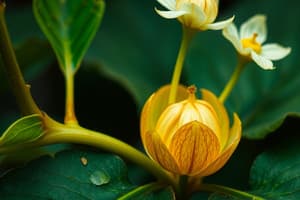Podcast
Questions and Answers
What is the main characteristic of vegetative propagation in plants?
What is the main characteristic of vegetative propagation in plants?
- Occurs exclusively in flowering plants
- Requires two parent plants for reproduction
- Produces offspring that are clones of the parent (correct)
- Involves genetic variation among offspring
Which of the following is NOT a modified part of the plant often used in vegetative propagation?
Which of the following is NOT a modified part of the plant often used in vegetative propagation?
- Stem tubers
- Flowers (correct)
- Runners
- Plantlets
What is one primary disadvantage of asexual reproduction in flowering plants?
What is one primary disadvantage of asexual reproduction in flowering plants?
- It offers no variation among offspring (correct)
- It requires significant energy investment
- It can lead to genetic variation
- It produces fewer plants than sexual reproduction
Which statement correctly describes micropropagation?
Which statement correctly describes micropropagation?
Which of the following methods is considered a form of artificial propagation?
Which of the following methods is considered a form of artificial propagation?
What advantage does sexual reproduction provide to flowering plants?
What advantage does sexual reproduction provide to flowering plants?
Which example correctly matches a modified leaf with its corresponding plant?
Which example correctly matches a modified leaf with its corresponding plant?
Which of the following is a disadvantage of sexual reproduction in flowering plants?
Which of the following is a disadvantage of sexual reproduction in flowering plants?
Which of the following is an example of a modified stem used in vegetative propagation?
Which of the following is an example of a modified stem used in vegetative propagation?
What is a key disadvantage of asexual reproduction in flowering plants?
What is a key disadvantage of asexual reproduction in flowering plants?
Which plant part is typically modified to form plantlets?
Which plant part is typically modified to form plantlets?
Which of the following methods is NOT a form of artificial propagation?
Which of the following methods is NOT a form of artificial propagation?
What is a benefit of using micropropagation in plant reproduction?
What is a benefit of using micropropagation in plant reproduction?
Which of these is a primary reason flowering plants engage in sexual reproduction?
Which of these is a primary reason flowering plants engage in sexual reproduction?
What is a common characteristic of a root tuber?
What is a common characteristic of a root tuber?
Which of the following characteristics is NOT true regarding asexual reproduction?
Which of the following characteristics is NOT true regarding asexual reproduction?
Flashcards are hidden until you start studying
Study Notes
Vegetative Propagation
- Asexual reproduction method in plants with one parent, resulting in offspring that are clones.
- Involves modification of certain plant parts for propagation purposes.
Modified Plant Parts for Propagation
- Stem: Runners (e.g., strawberry) and Stem tubers (e.g., potato).
- Root: Root tuber (e.g., Dahlia).
- Leaf: Plantlets (e.g., lily).
- Bud: Modified bulb (e.g., onion).
Advantages of Sexual Reproduction in Flowering Plants
- Enhances resistance to diseases through genetic diversity.
- Allows dispersal of seeds, reducing competition for resources.
Advantages of Asexual Reproduction in Flowering Plants
- Minimizes waste as no energy is spent on producing seeds.
- Enables rapid growth and establishment of new plants.
Disadvantages of Sexual Reproduction in Flowering Plants
- Young plants take considerable time to reach maturity.
- Can be wasteful due to energy expended on pollination and seed production.
Disadvantages of Asexual Reproduction in Flowering Plants
- Lacks genetic variation, making all clones susceptible to the same diseases.
- A single disease outbreak can wipe out entire populations of cloned plants.
Methods of Artificial Propagation
- Various techniques include cutting, layering, grafting, and micropropagation.
Micropropagation
- Involves removing cells from a plant and culturing them in a special medium to grow new plants.
Vegetative Propagation
- Asexual reproduction method in plants with one parent, resulting in offspring that are clones.
- Involves modification of certain plant parts for propagation purposes.
Modified Plant Parts for Propagation
- Stem: Runners (e.g., strawberry) and Stem tubers (e.g., potato).
- Root: Root tuber (e.g., Dahlia).
- Leaf: Plantlets (e.g., lily).
- Bud: Modified bulb (e.g., onion).
Advantages of Sexual Reproduction in Flowering Plants
- Enhances resistance to diseases through genetic diversity.
- Allows dispersal of seeds, reducing competition for resources.
Advantages of Asexual Reproduction in Flowering Plants
- Minimizes waste as no energy is spent on producing seeds.
- Enables rapid growth and establishment of new plants.
Disadvantages of Sexual Reproduction in Flowering Plants
- Young plants take considerable time to reach maturity.
- Can be wasteful due to energy expended on pollination and seed production.
Disadvantages of Asexual Reproduction in Flowering Plants
- Lacks genetic variation, making all clones susceptible to the same diseases.
- A single disease outbreak can wipe out entire populations of cloned plants.
Methods of Artificial Propagation
- Various techniques include cutting, layering, grafting, and micropropagation.
Micropropagation
- Involves removing cells from a plant and culturing them in a special medium to grow new plants.
Studying That Suits You
Use AI to generate personalized quizzes and flashcards to suit your learning preferences.




